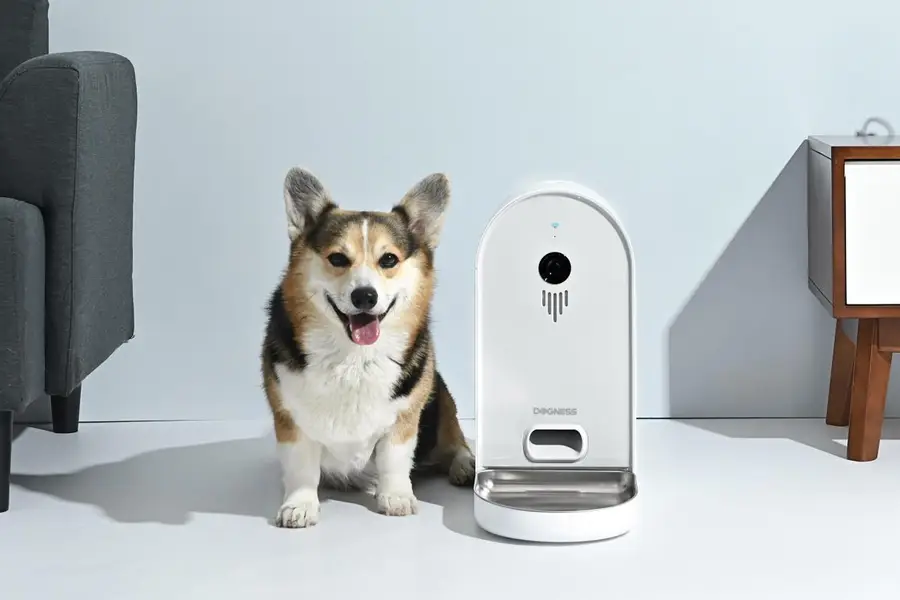Pet tech boom lifts Dogness revenue, but investors aren’t biting

The pet pioneer’s business is getting a lift from products like smart collars and intelligent feeders, even as its core leash business is in the doghouse
Key Takeaways:
- Dogness reported its revenue rose 39.5% in its fiscal year through June to $20.7 million, while its loss narrowed by 15.8% to $5.1 million
- The pet product seller’s shares have fallen by three quarters since the beginning of the year, despite strong growth for smart products in its latest fiscal year
By Edith Terry
Decades ago, Chen Silong, then 16, began his career working in a shoelace factory in Dongguan, the industrial city near Guangzhou that has been called the factory to the world. After trying his hand at a few different industries, Chen started a business printing and dyeing shoelaces for shoe factories in 2003 at the age of 22. From there he gradually expanded into carabiners, and then pet leashes, before founding his current company, Dogness (International) Corp. (DOGZ.US) in 2008.
Chen got his timing right with the rise of China’s pet economy, which initially boomed among millennials and continues to find strong demand from a GenZ that is more likely to raise pets than kids and treat pets as family. The country’s pet population is relatively stable, at about 124.1 million in 2024, and a new growth wave is coming from a vast array of pet products and services adding high-tech touches into traditional things like leashes and feeders.
After going public on the Nasdaq in 2017, Dogness hit a peak in 2022 as the pandemic created a worldwide boom in pet adoption. But the company has been in the doghouse since then, mired in losses and declining revenues, echoed by a relentless decline in its share price. Now, the pet tech wave is showing there could yet still be some life in the Dogness story, as reflected in its latest annual results for its fiscal year through June, released earlier this month.
The headline numbers showed the company is on the road to recovery, although its core pet leash business remains in the doldrums. Its revenue for the year increased by 39.5% to $20.7 million. But its income from “traditional pet products,” mainly leashes, fell by 4.1% to $8.6 million, dropping to 41% of total revenue from 60% the previous year.
Meanwhile, sales for the company’s kennel of intelligent pet products shot up 43.7% to $6.3 million, accounting for 30% of the total revenue. Such products cover a wide range, from cameras that allow owners outside their homes to keep an eye on their pets, to smart pet feeders.
While intelligent products performed well, Dogness recorded an even bigger jump in its sales of dog and cat harness carabiners or shackles, a low-tech product which it calls “climbing hooks,” which more than quadrupled to $5.76 million, taking it to 28% of sales.
The company continued to lose money despite the overall revenue growth, though its latest annual net loss of $5.1 million narrowed from $6.1 million the previous year, as it continued to make progress in clawing its way back to the black.
Dogness’ continued losses, even as sales return to a strong growth track, owes at least partly to intense competition, especially in an emerging area like pet tech, as companies undercut each other in a bid to gain market share. This is reflected in Dogness’ decline in its average selling price for both traditional and intelligent pet products between 2022 and 2025, even as unit sales rose by 0.3% for the former and 61.7% for the latter. Only carabiners and shackles bucked the trend, rising 0.3% in average selling price.
Dogness’ stock rose slightly after the results were released, but have given back those small gains and more since then and are now down nearly 20% from pre-announcement levels. The stock is down about 75% this year, bucking a broader tide that has seen many China stocks rise sharply over that time, showing the company has yet to convince investors that it can emerge from the money-losing doghouse and return to profitability.
Cash rich
Dogness has other virtues that suggest it may be worth a second look. Its cash position nearly doubled in 2025 to $12.8 million, following a $3.4 million construction project that depressed the total the previous year. It also seems to have little trouble raising money through private placements, including $5.9 million in 2025 and $4.9 million in 2024.
In its latest earnings report, Chen said U.S. tariffs have yet to impact Dogness. The company’s total international sales increased by a healthy 35.4% to $13.6 million, though that trailed the 48.1% growth in domestic sales to $7.1 million for the year. Sales to the U.S. nearly doubled, from $2.8 million in 2024 to $4.5 million in 2025.
The competition is severe. According to Tracxn, a data aggregator that monitors tech startups, of the 137 pet tech companies in China, only three of the top five have gone public. Dogness is one of those, alongside Boqii (BQ.US) and Hangzhou Tianyuan Pet Products (301335.SZ). Two other companies, Epet and Shanghai-based Petkit, have also engaged in some fundraising.
Shares of Boqii, focused on pet food, pet care and pet communities through its e-commerce platform, have tanked since the company’s 2020 IPO, leaving it with a market cap of just $23.6 million. The company’s issues echo some of the problems that Dogness had after the pandemic-era pet boom. Boqii’s revenue has fallen sharply and it lost money in each of the last three years.
Tianyuan straddles pet products and pet food, and has a much higher market cap of 3.84 billion yuan ($540 million). With 2024 revenue of 2.7 billion yuan, it is by far the largest of the three listed companies. And unlike its peers, Tianyuan is distinguished by being profitable, though its profit has fallen in the last few years.
Sales in China, which is still Dogness’ single largest market, accounting for about a third of its total, are being driven by a tech-friendly younger generation, steadily rising pet ownership and declining fertility rates. Petkit, like Dogness, makes internet-enabled pet feeders and water dispensers, as well as a self-cleaning litter box for cats. Both companies have apps that can direct feeders and litter boxes by long distance, as well as tracking the animal’s location.
China’s pet economy is far smaller than the $151 billion U.S. pet market, where 71% of all households, or 94 million, own pets. China’s market was behind that at about 300.2 billion yuan in 2024, according to the 2025 Chinese Pet Industry White Paper by Petdata.cn. But that market is expected to keep growing, fueled by emerging trends in aging pet care, AI-based advisory services, and experiential products and services that support the bond between pet and human. Petkit, for example, has its own AI health assistant, and about half of its employees are R&D staff, according to co-founder and CEO Guo Weixue.
To subscribe to Bamboo Works weekly free newsletter, click here






